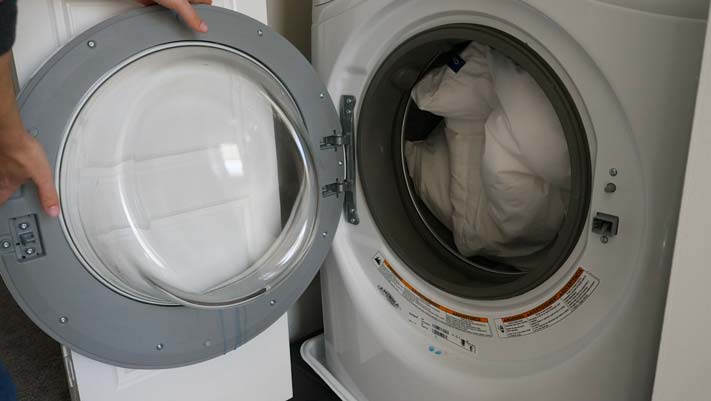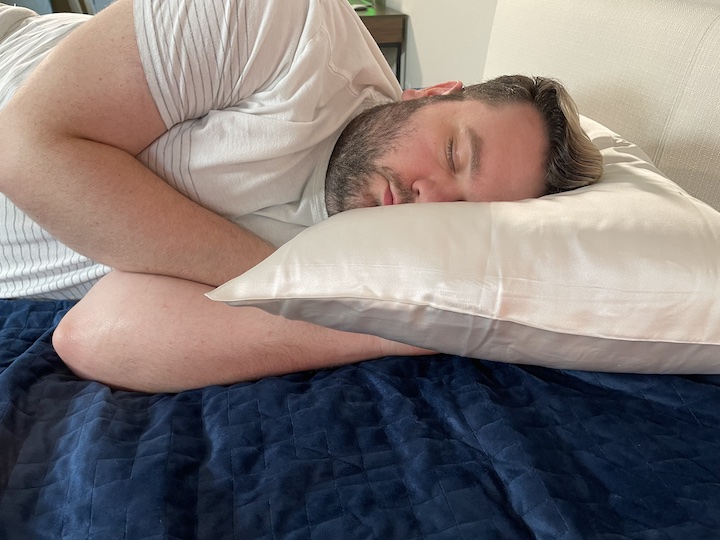Have you ever changed your pillowcase only to discover that your once-white pillow has turned yellow? Even with the proper care, a pillow can yellow over time. If you aren’t ready to replace your yellow pillow, we have some tips on how to remove yellow stains and how to prevent them.
What Causes Your Pillow to Turn Yellow
The main cause of yellowing pillows is moisture. Sweat and any moisture in your sleep environment is absorbed every night into your pillow. Read on below to learn more about the most common types of moisture responsible for yellow stains below.
Sweat
Sweat stains are the most common reason for pillow yellowing. We all sweat, and a normal amount of sweating happens during sleep to regulate our body temperature. However, excess sweat at night could be caused by sleeping in a warm environment or sleeping under warm bedding that traps heat.
If you are sweating heavily in your sleep, first try making small changes to your sleep environment like turning the temperature down in your bedroom or opting for thinner, more breathable sheets. If you make these changes and are still sweating excessively, consult your doctor if you believe your night sweats are a part of a greater health problem.
Wet Hair
If you shower at night and don’t dry your hair before falling asleep, this can cause pillow yellowing over time. Damp hair from water or hair products collects moisture on pillows, turning them yellow. It’s a common myth that sleeping on wet hair can give you a cold. While this is untrue, there are some negative consequences for your hair health.
Drool
Everyone drools in their sleep from time to time, especially if they are dealing with allergies or sleep with their mouth open. Like sweat, saliva can turn your pillow yellow over time.
Natural Body Oils
Our skin is covered in sebaceous glands that produce an oily substance called sebum from hair follicles. Most of a person’s sebaceous glands are located on the face and scalp. Excess sebum is absorbed by your pillowcase and pillow, and this moisture could be responsible for turning your pillow yellow.
Lotion, Face Cream and Beauty Products
Finally, face cream and other beauty products are the second biggest culprit behind yellow pillows. If you go through a skin care routine and go straight to bed, these products will transfer. So, we recommend putting on skin care products or lotion an hour or two before bed so they have more time to absorb. This will reduce the amount of moisture your pillow soaks up and reduce the appearance of yellow stains.
Is It Okay to Sleep on a Pillow With Yellow Stains
The most important qualities of your pillow is that it is comfortable and supportive. So, if your pillow has minimal yellow stains, keeps your head and neck aligned and feels comfortable, it is probably still fine to sleep on.
However, if your pillow is mostly stained or shows signs of wear like flattening out or smelling odd, then it’s time to get rid of your pillow. Later on, I’ll touch on other signs you need a new pillow.
How to Remove Yellow Stains From Your Pillow
If your pillows aren’t too yellow, you can probably wash the stains out. Depending on what your pillow is made of, it will only take a few easy steps to remove yellow stains.
Check Washing Instructions
The first and most important thing to do to remove yellow stains from your pillow is to check its care instructions. Some pillows can be put in a washing machine and dryer, but others cannot. Check to see if the pillow has a removable cover that can be machine-washed. Often, all-foam pillows will have a cover because foam should not be washed, as it will be damaged in the process. Check out our complete guide on how to clean your pillow for more information.

Spot-Treat Your Stains
If a pillow can’t be machine-washed, many brands will recommend spot cleaning. Take a damp cloth with water and gently wet the stained area, then take a mild detergent or cleaning solution and gently rub it. You can also use baking soda mixed with a little water as a home remedy. Let your preferred stain remover solution sit for a few hours before rinsing or further washing.
Machine-Washing Yellow Pillows
If your pillow is machine-washable, throw it in the washer according to its care instructions. To help whiten your pillows, you could add bleach or white vinegar to your mild detergent. In our experience, many brands will recommend non-chlorine bleach, so be sure to check the bleach you have if this is the route you go.
Most machine-washable pillows can be put in a dryer on a low heat setting. For the best results, place one to two dryer balls or tennis balls inside tube socks along with your pillows. These will bounce around inside the dryer and will redistribute its filling helping it to dry as efficiently as possible.
Pillows made from memory foam or natural latex cannot be put in the washing machine, so you’ll have to spot-clean them. Instead of rinsing your pillow in the washing machine, take the same damp cloth to remove any detergent or stain remover left behind. Let the pillow fully air dry in a ventilated area, preferably in direct sunlight.
How to Prevent Yellow Stains on Pillows
It’s great to know how to remove yellow stains from pillows, but it’s even better to know how to prevent them in the first place. These are our top three tips on how to do just that:
Use a Pillow Protector
Just like a mattress protector, a pillow protector is a fabric case that goes between your pillow and your pillowcase to prevent staining and yellowing. It is designed to provide extra protection to your pillow from sweat and oils, the main causes of yellow pillows. Look for a waterproof pillow protector to stop sweat, drool and beauty products from soaking into your pillow and ultimately extending its lifespan.
Use a Good Pillowcase
A pillowcase is meant to be a barrier between your skin and your pillow as well as add a layer of comfort. Most of us use one anyway, so investing in a high-quality case is important for keeping yellowing at bay. Some pillowcases keep your skin and hair healthy by not soaking up moisture. Others have cooling benefits that are great for hot sleepers that deal with night sweats. It’s best to wash your pillowcase once a week with your bed sheets.

RELATED: Best Pillowcases: Our Top 8 Picks
Wash Your Pillow Regularly
Washing your pillows tends to be an overlooked task, but it is an important part of bedding cleaning routine. Washing your pillow will remove harmful contaminants and make it more comfortable to sleep on. Your pillow should be washed at least every four to six months.
The material your pillow is made from will determine how to wash your pillow. For example, down pillows can be thrown in the washing machine and memory foam and latex pillows should be hand-washed, unless they have removable covers. The best way to know how to take care of your pillows is to read the care instructions on the tag or visit the brand’s website for more information.
When to Get a New Pillow
Pillows need to be replaced to ensure you get the best quality sleep. Over time, pillows flatten, collect bacteria and dust and become stained. When your pillow cannot fully support your head, smells like sweat or mildew after being cleaned or mostly loses its original color, it’s time to replace your pillow.
It’s recommended to get a new pillow every one to two years, or sooner if it shows signs of wear. Check out our list of best pillows as a guide for finding the right pillow for you.
The Takeaway
Pillows turn yellow over time because of moisture absorbed from your face and body. Yellow pillows are easy to clean and even easier to prevent. Yellow pillows are safe to sleep on, but should be replaced if they show signs or wear or turn mostly yellow or brown.
FAQs
Are yellow pillows bad?
Yellow pillows aren’t necessarily bad. It just means your pillow has been stained by sweat, oil and beauty products over time. If your pillow is still yellow after washing it, it might be time to buy a new pillow.
Is it normal for a pillow to turn yellow?
It’s completely normal for a pillow to turn yellow. Pillows turn yellow when they come in contact with moisture from your body or your bedroom.
How do you keep pillows from turning yellow?
There are a few things you can do to prevent your pillows from turning yellow. You can use a pillow protector along with a pillowcase to block moisture from coming in contact with your pillow. Also, it’s important to wash your bedding regularly, go to bed with dry hair and apply nighttime lotions an hour or two before getting into bed.
Should I throw away my yellow pillow?
You don’t have to throw away your pillow as soon as it turns yellow. First, wash your pillow according to the care instructions on its care tag or brand website. Then, check if your pillow is still stained or smells like mildew or is too flat to support your head. If any of these are true and your pillow is one to two years old, it’s definitely time to throw away your yellow pillow.

